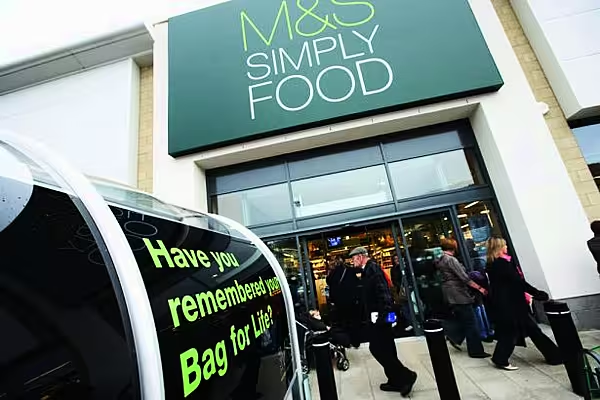It's one step forward, two steps back for Steve Rowe, chief executive of Marks & Spencer Group Plc.
Just when there are signs of improvement in the retailer's troubled clothing division, the food arm starts to wobble.
On the face of it, there wasn't much good news on fashion, either. Same-store sales of clothing and home furnishings fell by 1.2 percent in the three months to July 1, and that's after an uplift from Easter.
But dig a little deeper and there is evidence that M&S is finally making progress in apparel. Full-price clothing and home furnishing sales rose 7 percent in the period.
Under former CEO Marc Bolland, M&S's clothing yo-yoed between high prices and money-off promotions. Rowe is aiming for lower, more stable prices.
M&S removed 27 promotions during the period, and also didn't repeat a clearance sale in April, which dented same-store sales.
That's the right strategy, and should help M&S meet its expectations of a broadly steady clothing and home furnishings gross margin, even if it is weighing on the top line.
Food Slowdown
What's more worrying is the slowdown in food, where growth has been a bright spot over the past few years as clothing has stuttered. Same-store food sales were down by 0.1 percent, after a boost from Easter.
Rowe says the high rate of openings of new stand-alone Simply Food stores is taking some revenue from existing outlets. Those shops also don't benefit so much from hot weather because they have a smaller beer, wine and spirits range than the supermarkets.
But investors will remember the last recession, when the fortunes of M&S's food business slumped. Their groceries became too expensive for cash-strapped shoppers, plus faced competition from the mainstream supermarkets' top-end ranges and Waitrose Ltd., the grocery arm of the John Lewis Partnership. M&S was ultimately forced to lower prices to revive traffic.
Such drastic measures aren't necessary, yet. But as incomes are squeezed by inflation that's ahead of wage growth, there's a danger that M&S customers start to trade down. And this time round, not only the mainstream supermarkets but the German discounters Aldi Stores Ltd. and Lidl Stiftung & Co. have upped their game.
Although food is less profitable than clothing, M&S has pinned its hopes on grocery growth, so any stumble here is a concern.
Share Concern
Shares in M&S are down 17 percent since the group unveiled its 2016 annual earnings in May, including a drop of as much as 4.6 percent Tuesday. Nevertheless, they still trade on a forward price earnings ratio of 11.5 times, compared with Next Plc's 9.2 times.
There's no doubt that the outlook for M&S is rosier than for some time. Fashions and prices are moving in the right direction. As Rowe approaches the anniversary of culling promotions, he expects same-store clothing and home furnishing sales to move toward growth. And retail veteran Archie Norman takes over as chairman on September 1.
But as Gadfly has argued, M&S's recent history is littered with false dawns. The deceleration in food sales is another reason to believe expectations have gotten ahead of reality.
To justify the stock's premium, Rowe needs to demonstrate that his recovery isn't about to be undone by a posh food fight.
This column does not necessarily reflect the opinion of Bloomberg LP and its owners.
News by Bloomberg, edited by ESM. Click subscribe to sign up to ESM: The European Supermarket Magazine.














